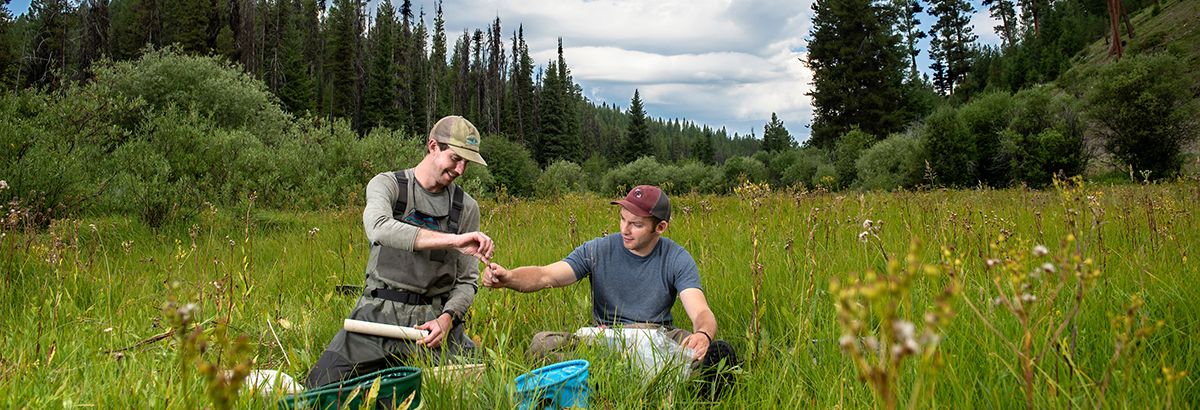Student Spotlight: Eric Palm
Eric Palm is a Ph. D. student in the wildlife biology program at the W.A. Franke College of Forestry and Conservation. His research focuses on woodland caribou in northwestern North America—roughly from Alberta to Alaska. In his dissertation, Palm’s goal is to understand how both human and fire disturbance will affect caribou populations and their habitat selection. Palm also works on NASA’s Arctic-Boreal Vulnerability Experiment (ABoVE) and was named a Wildlife Conservation Society-Canada Weston Fellow in 2017. He will defend his thesis in December of 2020.
Story Transcript
I'd say the biggest influence on me as far as my fascination with wildlife was visiting my grandparents on their farm in central Missouri. They had six hundred and fifty acres mostly forested and I would just spend about two or three weeks every summer just cruising around trying to see as many birds as I could, see as much wildlife as I could. Just being out there like in the woods and sitting down and being completely quiet and noticing everything around you is, is pretty cool. And I still like to do that.
My name is Eric Palm and I am a PhD student in the wildlife biology program at the 老虎机攻略.
I worked for several years on migratory waterfowl in North America. We captured hundreds of ducks and geese and swans and put little backpack transmitters on them to see where they go. And these transmitters gave us like a G.P.S. location every couple of hours and then we learned about their migration routes and their timing doing that work really got me interested in using that tracking technology to see where animals migrate. And that was kind of a big link to the caribou research that I'm doing now is because it's using some of the same technology and, and tracking animals moving across the landscape.
I had been interested in going back to school to get a PhD and then I saw this posting that had a lot of the things that I had done with birds but they were looking to do it with caribou and I thought that would be interesting because I don't know anything about caribou. I'd like to go up to where caribou live in Canada and Alaska. I'd like to see the boreal forest and the Arctic tundra.
So, I had a phone conversation with my potential advisor Mark Hebblewhite and that went really well. And he invited me to come to Missoula to check out the city, check out the university. I was sold on the town and the university and was excited to come.
I think Missoula is a really good place for me because it's got a lot of the activities that I like to do. It's got all these great mountain ranges right nearby. There's a bunch of rivers that are all over the place that are great rivers for paddling. I can go hiking or skiing or paddling within half an hour 45 minutes and a lot of other cities don't have that.
My project is on caribou. Very generally we have two main types of caribou. There's those that live in the tundra and then the ones that live farther south in the forest. And I'm studying the ones that live in the forest which are called woodland caribou. Woodland caribou populations have been declining for decades basically.
And, woodland caribou are declining because of human mediated increases in predation and what that means is that resource extraction, which includes oil exploration and extraction, logging, and mining and all of the roads that we need to do these things are basically fragmenting and destroying a lot of their preferred habitat which is old growth forests. But, what we've done is we've effectively made it a lot easier for predators to encounter caribou.
There's also this indirect effect through climate change that is affecting caribou. You could say that caribou are being squeezed so there's this top down pressure on caribou, this predation, and there's also potentially a bottom up pressure where more fires decreases their food availability which means that they are unable to eat enough to survive.
What caribou eat in the wintertime is lichen. A unique thing about lichen is that after a fire goes through it takes decades and decades to recover whereas most plants can come back in a matter of a few years. And so, if fires become more and more frequent then we think this will have a really negative impact on caribou food because lichen is the main source of their food in the winter.
In my dissertation my goal really is to understand how both human and fire disturbance will affect caribou habitat selection and affect their populations in general. I'm hoping that that my work will paint a much broader picture of how caribou populations are responding to changing conditions across all of northwestern North America. And it will help predict responses in the future and we can use all this information to then proactively protect these populations that are not yet declining.
I think the best experience that I've had so far working on this project is actually the few times that I've actually gone out into the field and gotten to fly over a huge tracts of the boreal forest and just see how big and expansive it is and see caribou from the air. The best moments are like, the things that remind me why I'm doing the work is when I'm actually out there seeing it.
